Beyond Twinkle, Twinkle: Using Music with Infants and Toddlers
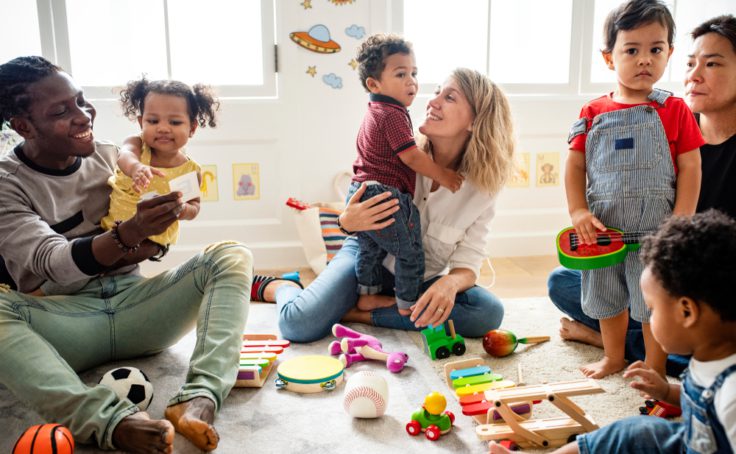
Music has a power that goes beyond words. The pleasure of sharing music builds connections between parent and child as sounds and rhythms surround the child in a world of sensations and feelings. Music also offers a joyful and rewarding learning experience and nurtures a child’s imagination and creativity. Learn about how music supports all areas of young children’s development.
Consider this example:
It is nap time, and 2½-year-old Benjamin wriggles on his cot, trying to get comfortable. “Sing my song,” he says. His teacher slowly starts to sing a song she made up several months ago, just for Benjamin.
“Who loves Benjamin? It’s his mommy and daddy. Who loves Benjamin? It’s big sister Madison. Who loves Benjamin? It’s Ms. Sharlene. Who loves Benjamin? It’s Miss Callie.” His teacher sings the names of many of the people in Benjamin’s life who love him. She watches Benjamin curl under his blanket, his eyes heavy with sleep.
For very young children , music has power and meaning that go beyond words. First, and most important, sharing music with young children is simply one more way to give love and receive love. Music and music experiences also support the formation of important brain connections that are being established over the first three years of life (Carlton 2000).
In this article, we explore the many ways that music promotes growth in the various developmental domains and how infant/toddler professionals can use music experiences to support children’s early learning.
Music and Early Development
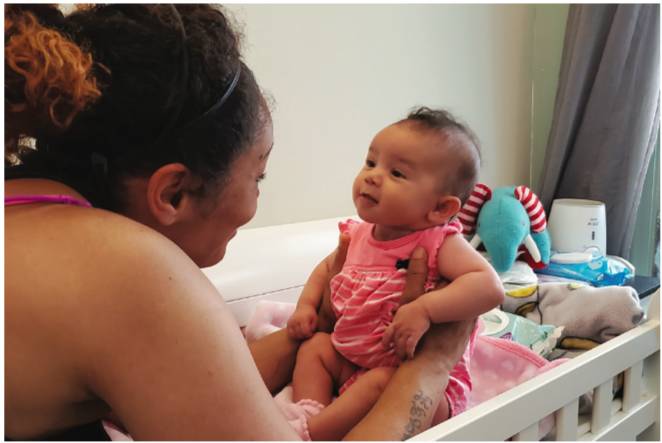
Like all the best learning experiences in early childhood, music activities simultaneously promote development in multiple domains. Singing a lullaby while rocking a baby stimulates early language development, promotes attachment, and supports an infant’s growing spatial awareness as the child experiences her body moving in space. Being intentional about integrating music into your program’s daily routines—thinking through, “What do I want the children to learn from this music experience?”—helps you design and choose activities to support specific developmental goals.
Social-emotional skills
Music, because it is so often shared with others in singing, dancing, and playing instruments together, is by its very nature a social experience. Music activities with infants and toddlers offer them many opportunities to:
- Learn and practice self-regulation. Think about the power of lullabies to soothe very young children. When adults help babies calm down, they are supporting the development of self-regulation (the ability to manage one’s emotional state and physical needs). The experience of being soothed also helps babies learn to soothe themselves.
- Understand emotions. Singing about feelings helps babies and toddlers learn the words to describe their emotional experiences (“If you’re happy and you know it…”). The fact is that music evokes feelings—even when there are no words. One recent study found that babies as young as 5 months old are able, under some conditions, to discriminate between happy and sad musical excerpts (Flom, Gentile, & Pick 2008).
- Cooperate and build relationships. Music is often a team effort, with each participant adding his sound or voice to the mix. Imagine a parade of toddlers banging instruments as they march through the child care center. Music experiences, in which children use their own voices or play instruments, are especially good choices for very young children. Because music activities typically do not require sharing—a skill most toddlers are still working on they encourage positive peer interactions and can form the basis of toddlers’ first friendships.
- Experience self-esteem, self-confidence, and selfefficacy. Babies and young toddlers develop a sense that they are smart and competent when they can make an impact on their world. Think of a baby’s huge toothless grin when she makes a rattle go chicka chicka or a toddler’s careful attention as he taps on a xylophone to hear it chime.
- Share and take turns. Music very naturally encourages turn taking. Picture babies passing instruments back and forth to a teacher or toddlers taking turns with the classroom’s toy drums. Caregivers may repeat the sounds a baby makes with his voice or rattle; toddlers and their teachers can take turns playing musical solos while the others listen. Incorporating call-and-response songs (“Who Ate the Cookies from the Cookie Jar?”, “Boom Chicka Boom”) into your daily activities with toddlers also encourages turn taking.
- Develop cultural awareness. Playing songs and using musical styles from children’s home cultures create continuity between home and the caregiving setting. This nurtures children’s feelings of safety and security and validates the importance of their culture and language.
Physical (motor) skills
Be it the muscles in the lips used to form words in a melody, the small muscles of the hands used to hold a drumstick or whistle, or the large muscles in the legs and arms as children dance, music is a physical activity. It supports:
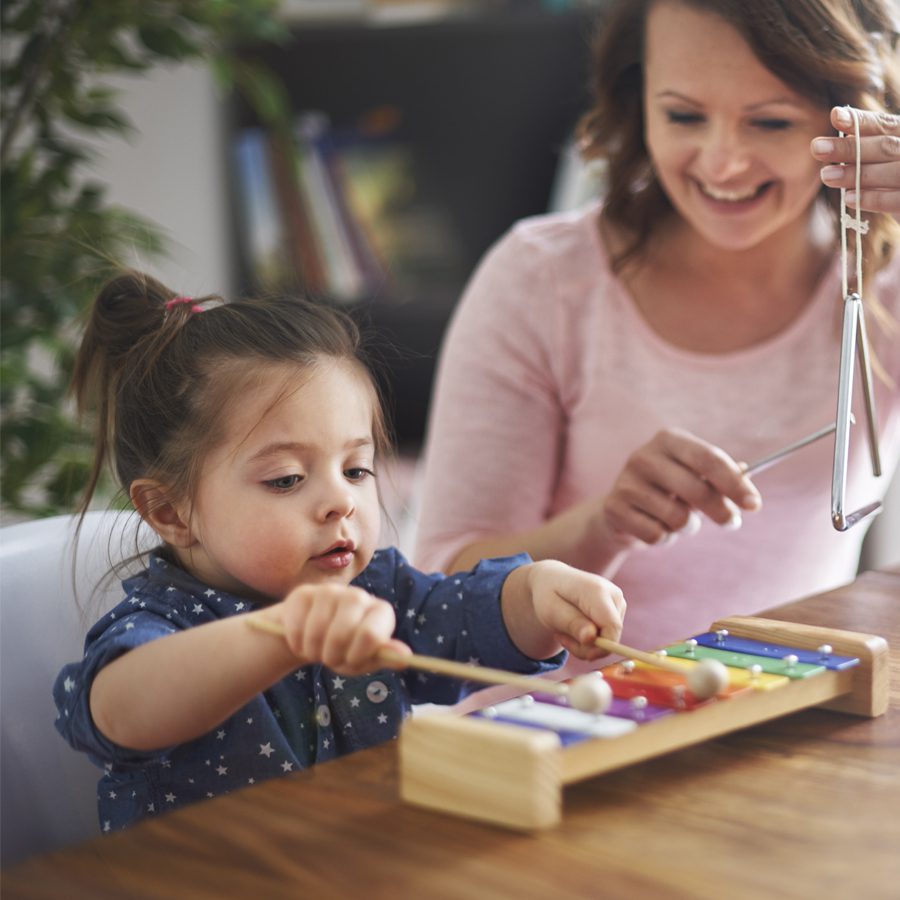
- Gross motor development. When people think about music, dancing is one of the first activities that come to mind. Dancing (to both fast and slow music), being held and rocked to music (both fast and slow), and making musical sounds by snapping colorful scarves in the air or jumping on bubble wrap are all melodic ways that very young children can build the muscles in their arms, legs, and trunk.
- Fine motor development. Finger plays like Where Is Thumbkin? or Open, Shut Them and interactive songs like “The Wheels on the Bus” (among many others) are perfect examples of ways music can support the development of small muscles in children’s hands and fingers—the same muscles they will use for writing and drawing when they are older.
Playing songs and using musical styles from children’s home cultures create continuity between home and the caregiving setting.
- Balance. In moving one’s body to music, children can stand while swaying or shifting their weight from one foot (or side of the body) to the other—which means they can balance. Imagine that “Let’s Do the Twist” fills the room. Young toddlers try to copy their family child care provider’s movements, twisting and shaking to the beat, while attempting to stay balanced and not fall over! (Of course, falling over is often the fun part.)
- Body awareness. Moving different parts of a baby’s body and encouraging toddlers to move their own bodies as you sing a song—for example, “Head, Shoulders, Knees and Toes”—helps them learn that these body parts do, indeed, belong to them.
- Bilateral coordination or crossing the midline. Bilateral coordination is the ability to use both sides of the body together, like when climbing stairs or playing a piano. This skill requires both sides of the brain to communicate to coordinate the body’s movements. Crossing the midline (when a child uses one part of the body in the space of the other part) is an activity that requires good bilateral communication. Picture a child playing a drum with both hands, passing a maraca from one hand to the other, dancing the Hokey Pokey (putting one leg in and one leg out). Teachers can also hold an egg shaker in a way that requires babies to reach across their bodies to grab it.
Thinking (cognitive) skills
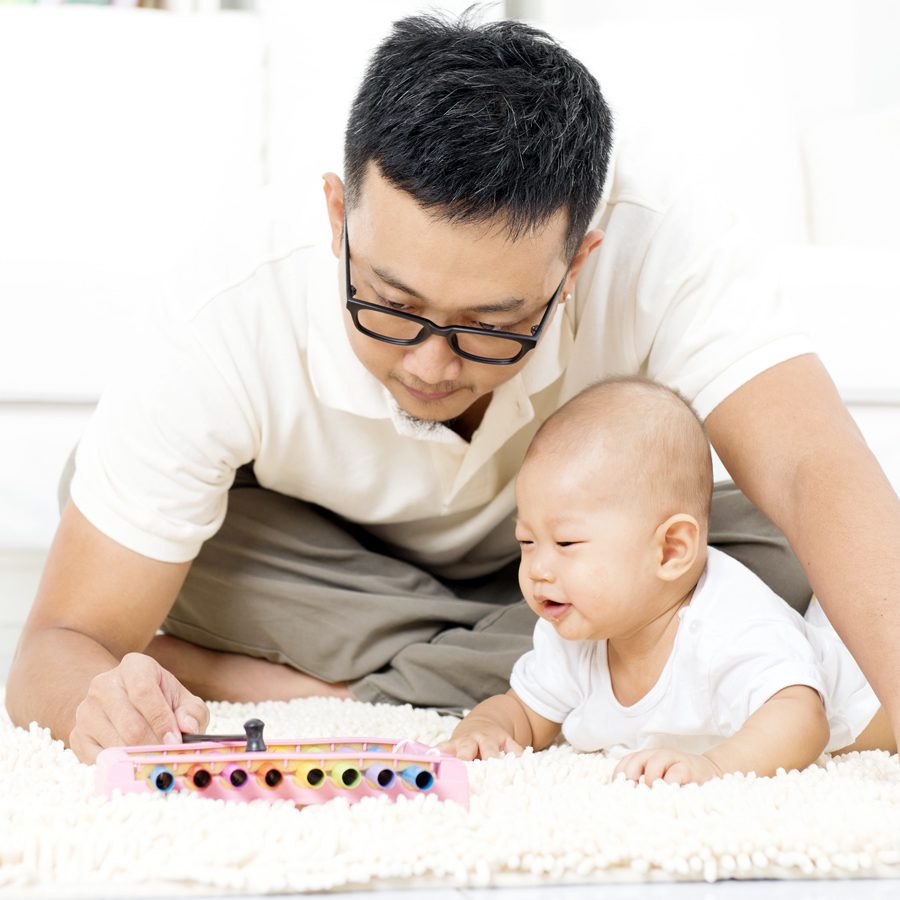
Music quite naturally provides opportunities to practice patterns, math concepts, and symbolic thinking skills, all in the context of a joyful noise—which makes it an attractive, engaging activity for very young children. There are many ways to participate in music experiences. Thus, they are easily adapted for a range of developmental levels and abilities, making it perfect for mixed-age settings as well as family child care programs.
- Counting. Many songs introduce numbers and counting: “One, Two, Buckle My Shoe,” “Five Little Monkeys,” “This Old Man,” and “The Animals Came in Two by Two” are just a few examples. The rhythm and repetition of songs may make it easier for very young children to remember the name and sequence of number patterns (see the next paragraph for more about this concept).
- Patterns and sequencing. Almost every piece of music has a pattern or sequence built into its melody or lyrics. Learning to anticipate patterns and place objects or events in sequence builds critical early math and early reading skills. Choose songs that are repetitive in rhythm or lyrics to help children learn to anticipate patterns (“Pop Goes the Weasel,” “Old MacDonald Had a Farm”). Share songs that tell a story (“Froggy Went A-Courtin’”) or ones that have a clear beginning, middle, and end (“The Farmer in the Dell”) to help children learn to decipher sequences in music.
Music quite naturally provides opportunities to practice patterns, math concepts, and symbolic thinking skills.
- Steady beat. Being aware of the steady beat involves clapping or patting out the beat to a piece of music or a nursery rhyme. Research has found that children’s personal tempo (ability to feel and express a steady beat) correlates with achievement test scores in grades 1 and 2 (Weikert, Schweinhart, & Larner 1987).
- Memory. Music holds a powerful place in our memory. Even babies as young as 8 months have shown recognition of a familiar piece of music after a two-week delay (Ilari & Polka 2006). Providing consistent experiences with the same song (at the same time, such as nap time) helps young babies remember and link that music with a particular experience.
- Discrimination or observation of differences. Through experience with different instruments and types of music, children slowly become aware of differences in pitch, timbre, tone, and volume. Even young babies will look surprised when one egg shaker makes a different sound from all the others. In fact, a very interesting study asked mothers to record two versions of the same song—one version in which the mother sang directly to her child and one version in which she sang to herself (the baby was not present). Infants (ages 4 to 7 months) showed a preference for the infant-directed versions, and the degree of preference correlated with the loving quality in the mother’s tone (Trainor 1996).
- Pretend play and symbolic thinking. Learning that one object (a block) can represent another object (a car) is a major leap in children’s thinking skills. Use music to build on toddlers’ growing abilities to use symbols by providing props to go along with songs—stuffed spiders when singing “Itsy Bitsy Spider” or fruit shapes cut out of felt to go along with the toddler favorite, “Fruit Salad.”
Language and literacy skills
If you ask which area of development music impacts the most, the majority of people will mention language skills. In fact, music activates literacy and language learning in many ways.
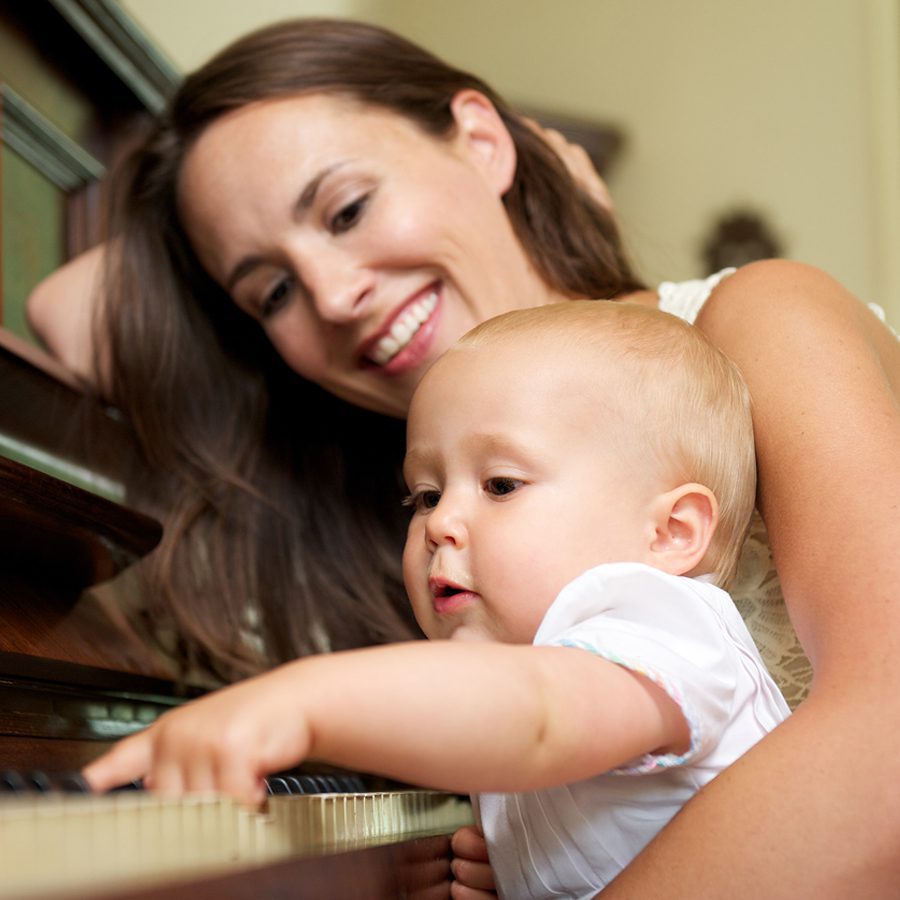
- Spoken language. Music gives children an easy-to-enter window into practicing language and deciphering meaning. Modifying the words in well-known songs (such as singing “Happy lunchtime to you!”) or asking older toddlers to fill in the blanks in singing (for example, “[Dante] had a little [fish], whose fins were bright and orange”) encourages children to practice logical thinking and reasoning skills.
- Dual language learning. Offering music experiences in children’s home language(s) supports dual language development in the first three years and beyond. Music also is a great means to involve families in the program as they share their culture’s songs and rhymes.
- Receptive language. Listening to music is an exercise in receptive language skills (words that children understand but may not yet be able to say). But remember, music need not have words to communicate feelings or images. For example, it is easy to decipher the elephants, kangaroos, and other creatures strutting through the orchestral recording of The Carnival of the Animals, by composer Camille Saint-Saëns. Toddlers who are just beginning to develop the ability to pretend play will revel in hearing and acting out this animal parade.
- Phonemic awareness. Phonemic awareness describes how well a child can hear, recognize, and use different sounds (called phonemes). For example, in the word cat there are three different phonemes: the /k/ sound, the short /a/ sound, and the /t/ sound. Children who are able to distinguish different sounds and phonemes are more likely to develop stronger literacy skills over time (Ehri et al. 2001). Music supports this critical skill because most songs include rhyming (or substituting one phoneme for another) (U.S. Department of Health and Human Services, forthcoming). For example, in the song “I’m a Little Teapot,” the words stout, spout, shout, and out all rhyme.
Singing From the Same Songbook: Ideas to Try
How can music support children’s development as they grow? How can early childhood teachers modify the ways in which they use music to reflect a child’s new skills and abilities?
Just as children play differently with blocks at age 6 months (mouthing) than at age 2 years (stacking), they also experience music differently as they grow. Thoughtfully planned music experiences can support and nurture each developmental domain— social-emotional, physical (motor), thinking (cognitive), and language and literacy.
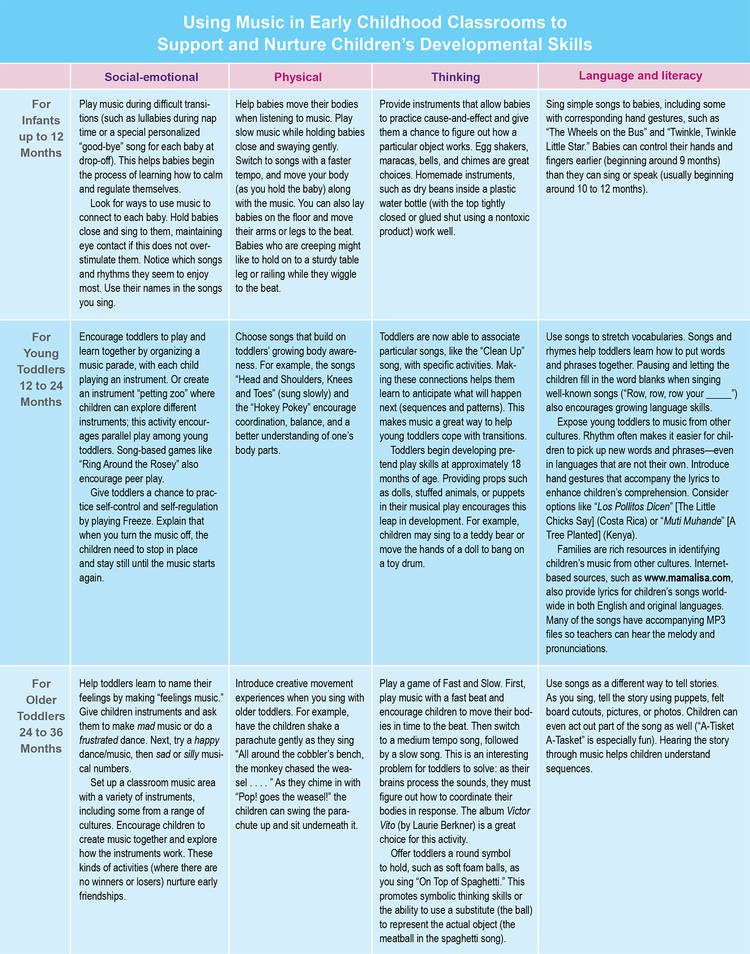
The Finale
Music plays a powerful role in the lives of young children. Through music, babies and toddlers can come to better understand themselves and their feelings, learn to decipher patterns and solve problems, and discover the world around them in rich, complex ways. Most important, sharing music experiences with the people they love makes very young children feel cherished and important—to paraphrase the well-known advertisement: “The cost of an egg shaker? $4. The cost of a parachute? $50. Using music activities to enrich the lives of babies and toddlers? Priceless!”
References
Carlton, E.B. 2000. Learning through music: The support of brain research. Child Care Exchange 133 (May/June): 53–56.
Ehri, L.C., D. Willows, B. Schuster, Z. Yaghoubzadeh, & T. Shanahan. 2001. Phonemic awareness instruction helps children learn to read: Evidence from the National Reading Panel’s meta-analysis. Reading Research Quarterly 36: 250–86.
Flom, R., D.A. Gentile, & A.D. Pick. 2008. Infants’ discrimination of happy and sad music. Infant Behavior and Development 31 (4): 716–28.
Ilari, B., & L. Polka, L. 2006. Music cognition in early infancy: Infants’ preferences and long-term memory for Ravel. International Journal of Music Education 24 (1): 7–20.
Trainor, L.J. 1996. Infant preferences for infant-directed versus noninfant-directed playsongs and lullabies. Infant Behavior and Development 19 (1): 83–92.
U.S. Department of Health and Human Services, Administration for Children and Families, Office of Head Start. Forthcoming. Music—News you can use.
Weikart, P.S., L.J. Schweinhart, & M. Larner. 1987. Movement curriculum improves children’s rhythmic competence. HighScope ReSource 6 (1): 8–10.
